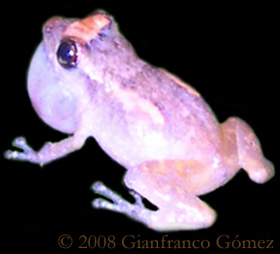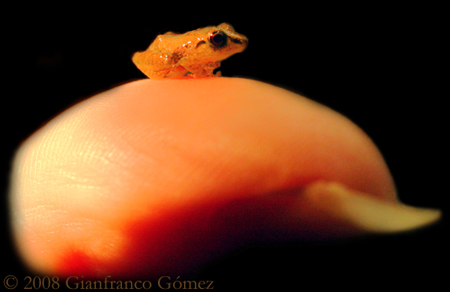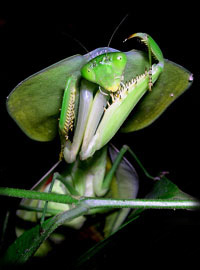|
Discover the
hidden treasures of Drake Bay, Costa Rica with Tracie "The Bug Lady" .

Home

Tour
Basics

Meet the Bug
Lady

Tales from the
Edge

Photo Gallery

Reservations



Facts about Drake Bay, Costa Rica

Travel To Drake Bay

Drake Bay Area Map

Hotel Information

Tips for Travelers

Tours

Recommended
Reading

|
|
|
 Despite
their small size, Tink Frogs liven up the jungle night with their
delicate chimes. Adult males, the ones that do all the singing, measure just over 20 millimeters at their largest. Females are a bit
larger and may measure up to 24 millimeters when fully grown. Still,
their call is one of the loudest night sounds you will hear during
the rainy season. During the dry season they are completely silent. Despite
their small size, Tink Frogs liven up the jungle night with their
delicate chimes. Adult males, the ones that do all the singing, measure just over 20 millimeters at their largest. Females are a bit
larger and may measure up to 24 millimeters when fully grown. Still,
their call is one of the loudest night sounds you will hear during
the rainy season. During the dry season they are completely silent.
There are two species of Tink Frog in Costa Rica. The Common Tink
Frog (Diasporus
diastema) and the Montane Tink Frog (Diasporus
hylaeformis). Both species are very similar, but the Montane
Tink Frog inhabits highlands whereas the Common Tink Frog is mainly
a lowland species. The Common Tink Frog is the species found in
Drake Bay. They inhabit the humid lowlands on the Caribbean and
southwestern Pacific regions of Costa Rica. They are also found at
the base of the Guanacaste and Tilaran Mountain Ranges. |
|
 During
their mating season, males generally call from hidden locations. We
have found them calling inside dead leaves, in very tangled vine
clumps, and in the cavities of plants like Bromeliads and Corn
Plants. Tink Frogs are strictly tree dwellers and they are
typically found from 1 to 35 meters off the ground. We often hear
them calling from bromeliad laden treetops. During
their mating season, males generally call from hidden locations. We
have found them calling inside dead leaves, in very tangled vine
clumps, and in the cavities of plants like Bromeliads and Corn
Plants. Tink Frogs are strictly tree dwellers and they are
typically found from 1 to 35 meters off the ground. We often hear
them calling from bromeliad laden treetops.
Their call is a very loud,
high pitched "Tink!". Studies suggest there is a calling order,
where a dominant male inaugurates the calling sessions and other
males in the group respond in their respective order. The calling
order helps to throw off any predator locating the frogs by hearing.
This, along with their small size, their habit of calling from
hidden perches and the fact that their call is nearly impossible to
home in on, makes every encounter with this very common frog a
special occasion.
They must be secretive when
they call because a whole host of predators, including Smoky Jungle
Frogs, Fringe-lipped Bats, Marine Toads and Four-eyed Opossums all
locate male frogs by their call and make a mini-meal out of them.
|
|
 While
calling a male frog's throat sac becomes quite inflated, as can be
seen pictured on the right. If a female is attracted into his
territory, he will approach her immediately calling repeatedly. The
male will stop in front of her and lift his legs up and down. She
will respond by bumping his extended throat sac with her snout. The
male will then bump and touch the female. This ritual may be
repeated several times. While
calling a male frog's throat sac becomes quite inflated, as can be
seen pictured on the right. If a female is attracted into his
territory, he will approach her immediately calling repeatedly. The
male will stop in front of her and lift his legs up and down. She
will respond by bumping his extended throat sac with her snout. The
male will then bump and touch the female. This ritual may be
repeated several times.
Eventually, he will lead her
back to a nest he has previously prepared. Nest sites are generally
a few centimeters to several meters off the ground and may be
located hidden in Bromeliads, leaf petioles, or under bark.
|
|
Once they reach the nest site, they will join in axillary amplexus
and mate. She will usually lay between 11 and 19 eggs.
 The
eggs go through direct development, so what will hatch out is not a
tadpole, but a fully formed frog. Embryos do go through tadpole
stage inside the egg, but will never have a free swimming aquatic
phase. The
eggs go through direct development, so what will hatch out is not a
tadpole, but a fully formed frog. Embryos do go through tadpole
stage inside the egg, but will never have a free swimming aquatic
phase.
The very next night, after mating, that little male will be out
calling again. If he attracts another female, they will go through
the same process again and he will lead her back to the same nest,
where she will lay her eggs. Scientists have found from three to
seven egg clutches at Tink Frog nests, all in different stages of
development. |
|
 Egg
clutches will normally hatch 23 to 26 days after being laid. When
the tiny froglets emerge from the eggs, they are just incredible.
You can get an idea of their size from the picture on the left. We
discovered this neonate, photographed perched on Tracie's thumb,
while on a Night Tour in the month of August. Egg
clutches will normally hatch 23 to 26 days after being laid. When
the tiny froglets emerge from the eggs, they are just incredible.
You can get an idea of their size from the picture on the left. We
discovered this neonate, photographed perched on Tracie's thumb,
while on a Night Tour in the month of August. |
|
References:
Forsyth, A. 1990 Portraits of the Rainforest
Camden House Publishing
Janzen, D. 1983 Costa Rican Natural History
University of Chicago Press
Leenders, T.
2001 A Guide to Amphibians and Reptiles of Costa Rica
Zona Tropical
Savage, J. 2002 The Amphibians and Reptiles of
Costa Rica University of Chicago Press
|
|
|
|
The Frog
Files





    


v



 |
